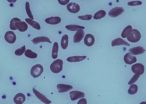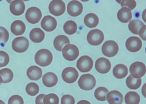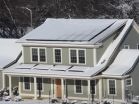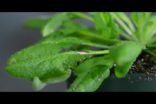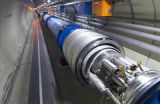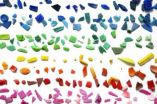(Press-News.org) Adults stop anti-rejection drugs after stem-cell transplant reverses sickle cell disease
NIH trial success suggests a new treatment option for older, sicker patients
Half of patients in a trial have safely stopped immunosuppressant medication following a modified blood stem-cell transplant for severe sickle cell disease, according to a study in the July 1 issue of the Journal of the American Medical Association. The trial was conducted at the National Institutes of Health's Clinical Center in Bethesda, Maryland, by researchers from NIH's National Institute of Diabetes and Digestive and Kidney Diseases (NIDDK) and the National Heart, Lung, and Blood Institute.
The transplant done in the study reversed sickle cell disease in nearly all the patients. Despite having both donor stem-cells and their own cells in their blood, the patients stopped the immunosuppressant medication without experiencing rejection or graft-versus-host disease, in which donor cells attack the recipient. Both are common, serious side effects of transplants.
"Typically, stem-cell recipients must take immunosuppressants all their lives," said Matthew Hsieh, M.D., lead author on the paper and staff clinician at NIH. "That the patients who discontinued this medication were able to do so safely points to the stability of the partial transplant regimen."
In sickle cell disease (SCD) sickle-shaped cells block blood flow. It can cause severe pain, organ damage and stroke. The only cure is a blood stem-cell, or bone marrow, transplant. The partial transplant performed in the study is much less toxic than the standard "full" transplant, which uses high doses of chemotherapy to kill all of the patient's marrow before replacing it with donor marrow. Several patients in the study had less than half of their marrow replaced.
Immunosuppressant medication reduces immune system strength and can cause serious side effects such as infection and joint swelling. In this study, 15 of 30 adults stopped taking the medication under careful supervision one year after transplant and still had not experienced rejection or graft-versus-host disease at a median follow up of 3.4 years.
"Side effects caused by immunosuppressants can endanger patients already weakened by years of organ damage from sickle cell disease," said John F. Tisdale, M.D., the paper's senior author and a senior investigator at NIH. "Not having to permanently rely on this medication, along with use of the relatively less-toxic partial stem-cell transplant, means that even older patients and those with severe sickle cell disease may be able to reverse their condition."
"One of the most debilitating effects of sickle cell disease is the often relentless pain," added Dr. Hsieh. "Following the transplant, we saw a significant decrease in hospitalizations and narcotics to control that pain."
The partial transplant used donor stem-cells from healthy siblings. It effectively reversed SCD in 26 of 30 patients and allowed them to achieve stable mixed donor chimerism, a condition in which a person has two genetically distinct cell types in the blood. The study includes patients from an NIH study reported in 2009, in which partial stem-cell transplants reversed SCD in 9 of 10 people.
In the United States, more than 90,000 people have SCD, a genetic disorder found mainly in people of African ancestry. Worldwide, millions of people have the disease.
"The devastating complications associated with sickle cell disease can deeply affect quality of life, ability to work and long-term well-being," said NIDDK Director Griffin P. Rodgers, M.D., a co-author on the paper. "This study represents an important advance in our efforts to make a potentially transformative treatment available to a wider range of people, especially those who could not tolerate a standard stem-cell transplant or long-term use of immunosuppressants."
INFORMATION:
People with sickle cell disease interested in joining NIH blood stem-cell transplant studies may call 1-800-411-1222 or visit http://www.clinicaltrials.gov for more information.
The NIDDK, part of the NIH, conducts and supports basic and clinical research and research training on some of the most common, severe and disabling conditions affecting Americans. The institute's research interests include: diabetes and other endocrine and metabolic diseases; digestive diseases, nutrition, and obesity; and kidney, urologic and hematologic diseases. For more information, visit http://www.niddk.nih.gov.
Part of the NIH, the National Heart, Lung, and Blood Institute (NHLBI) plans, conducts, and supports research related to the causes, prevention, diagnosis, and treatment of heart, blood vessel, lung, and blood diseases; and sleep disorders. The institute also administers national health education campaigns on women and heart disease, healthy weight for children, and other topics. NHLBI news releases and other materials are available online at: http://www.nhlbi.nih.gov.
The NIH Clinical Center (CC) provided clinical laboratory and transfusion medicine support and care for stem-cell donors and recipients. The CC is the clinical research hospital for the NIH. Through clinical research, physician-investigators translate laboratory discoveries into better treatments, therapies and interventions to improve the nation's health. For more information, visit http://clinicalcenter.nih.gov.
The Sidney Kimmel Cancer Center at Johns Hopkins Medical Institute provided input into trial design.
About the National Institutes of Health (NIH): NIH, the nation's medical research agency, includes 27 institutes and centers and is a component of the U.S. Department of Health and Human Services. NIH is the primary federal agency conducting and supporting basic, clinical, and translational medical research, and is investigating the causes, treatments, and cures for both common and rare diseases. For more information about NIH and its programs, visit http://www.nih.gov.
NIH…Turning Discovery Into Health
More information on sickle cell disease is available at:
http://www.nhlbi.nih.gov/health/dci/Diseases/Sca/SCA_WhatIs.html and
http://diabetes.niddk.nih.gov/dm/pubs/hemovari-A1C/.
Adults stop anti-rejection drugs after stem-cell transplant reverses sickle cell disease
NIH trial success suggests a new treatment option for older, sicker patients
2014-07-01
ELSE PRESS RELEASES FROM THIS DATE:
Seeing your true colors: Standards for hyperspectral imaging
2014-07-01
Today, doctors who really want to see if a wound is healing have to do a biopsy or some other invasive technique that, besides injuring an already injured patient, can really only offer information about a small area. But a technology called hyperspectral imaging offers doctors a noninvasive, painless way to discriminate between healthy and diseased tissue and reveal how well damaged tissue is healing over a wide area. The catch? A lack of calibration standards is impeding its use.
After a successful non-human trial, researchers at the National Institute of Standards ...
New NIST metamaterial gives light a one-way ticket
2014-07-01
The light-warping structures known as metamaterials have a new trick in their ever-expanding repertoire. Researchers at the National Institute of Standards and Technology (NIST) have built a silver, glass and chromium nanostructure that can all but stop visible light cold in one direction while giving it a pass in the other.* The device could someday play a role in optical information processing and in novel biosensing devices.
In recent years, scientists have designed nanostructured materials that allow microwave or infrared light to propagate in only one direction. ...
Fear, not data, motivates sunscreen users, research shows
2014-07-01
BUFFALO, N.Y. – We're often told that worrying can be harmful to one's health. But University at Buffalo researchers say that when it comes to preventing skin cancer, a little fear is good for you.
In a study published in the Journal of Behavioral Medicine, the UB researchers found that fear and worry about skin cancer had a bigger influence on people's use of sunscreen than information about the statistical likelihood of developing the disease.
"Most health behavior studies don't account for the more visceral, emotional reactions that lead people to do risky behaviors, ...
NIST test house exceeds goal; ends year with energy to spare
2014-07-01
The net-zero energy test house at the National Institute of Standards and Technology (NIST) in suburban Washington, D.C., not only absorbed winter's best shot, it came out on top, reaching its one-year anniversary on July 1 with enough surplus energy to power an electric car for about 1,440 miles.*
Watch the YouTube video at https://www.youtube.com/watch?v=iJZrOhPk4kg
Despite five months of below-average temperatures and twice the normal amount of snowfall, NIST's Net-Zero Energy Residential Test Facility (NZERTF) ended its one-year test run with 491 kilowatt hours ...
Biomarker predicts effectiveness of brain cancer treatment
2014-07-01
Researchers at the University of California, San Diego School of Medicine have identified a new biomarker that predicts whether glioblastoma – the most common form of primary brain cancer – will respond to chemotherapy. The findings are published in the July print issue of Oncotarget.
"Every patient diagnosed with glioblastoma is treated with a chemotherapy called temozolomide. About 15 percent of these patients derive long-lasting benefit," said Clark C. Chen, MD, PhD, vice-chairman of Academic Affairs, Division of Neurosurgery, UC San Diego School of Medicine and the ...
Plants respond to leaf vibrations caused by insects' chewing, MU study finds
2014-07-01
VIDEO:
Experiments by Heidi Appel and Rex Cocroft at the University of Missouri mark the first time scientists have shown that a plant responds to an ecologically relevant sound in its...
Click here for more information.
COLUMBIA, Mo. – Previous studies have suggested that plant growth can be influenced by sound and that plants respond to wind and touch. Now, researchers at the University of Missouri, in a collaboration that brings together audio and chemical analysis, have ...
Reigning in chaos in particle colliders yields big results
2014-07-01
WASHINGTON D.C., June 30, 2014 – When beams with trillions of particles go zipping around at near light speed, there's bound to be some chaos. Limiting that chaos in particle colliders is crucial for the groundbreaking results such experiments are designed to deliver.
In a special focus issue of the journal Chaos, from AIP Publishing, a physicist at the European Organization for Nuclear Research (CERN) details an important method of detecting and correcting unwanted chaotic behavior in particle colliders. The method is helping accelerator physicists design high-performing, ...
Research reveals a gender gap in the nation's biology labs
2014-07-01
CAMBRIDGE, MA -- Among the sciences, biology consistently attracts the greatest numbers of women to graduate school and academic careers. About half of all biology graduate students are women, and 40 percent of biology postdocs are female. However, those numbers drop dramatically among faculty members: Nationwide, only 36 percent of assistant professors and 18 percent of full professors are women.
A new study reveals a possible explanation for this discrepancy: In the labs of the highest-achieving male biology professors — winners of the Nobel Prize, the National Medal ...
Study reveals that many people are oblivious to how they come across to counterparts and colleagues
2014-07-01
NEW YORK—Jill Abramson was recently ousted from her position as the executive editor of The New York Times for being, among other things, too "pushy." But did Abramson—who has also been described by the media as "polarizing" and "brusque"—know during the course of her tenure that others viewed her as being overly assertive? A new study from the Columbia Business School suggests that there's a great chance she didn't.
"Finding the middle ground between being pushy and being a pushover is a basic challenge in social life and the workplace. We've now found that the challenge ...
All the world's oceans have plastic debris on their surface
2014-07-01
However, central surface waters of the oceans may not be the final destination of plastic debris since, as indicated by the study performed by the Malaspina Expedition, large amounts of microplastics could be passing to the marine food chain and the ocean floor. Results of the study, led by the University of Cadiz (Spain), have been published in the journal Proceedings of the National Academy of Sciences (PNAS).
Andrés Cózar, researcher from the University of Cadiz, explains: "Ocean currents carry plastic objects which split into smaller and smaller fragments due to solar ...
LAST 30 PRESS RELEASES:
Structure of dopamine-releasing neurons relates to the type of circuits they form for smell-processing
Reducing social isolation protects the brain in later life
Keeping the heart healthy increases longevity even after cancer
Young adults commonly mix cannabis with nicotine and tobacco
Comprehensive review illuminates tau protein's dual nature in brain health, disease, and emerging psychiatric connections
Book prepares K-12 leaders for the next public health crisis
Storms in the Southern Ocean mitigates global warming
Seals on the move: Research reveals key data for offshore development and international ecology
Sports injuries sustained during your period might be more severe
World's first successful 2 Tbit/s free-space optical communication using small optical terminals mountable on satellites and HAPS
Can intimate relationships affect your heart? New study says ‘yes’
Scalable and healable gradient textiles for multi‑scenario radiative cooling via bicomponent blow spinning
Research shows informed traders never let a good climate crisis go to waste
Intelligent XGBoost framework enhances asphalt pavement skid resistance assessment
Dual-function biomaterials for postoperative osteosarcoma: Tumor suppression and bone regeneration
New framework reveals where transport emissions concentrate in Singapore
NTP-enhanced lattice oxygen activation in Ce-Co catalysts for low-temperature soot combustion
Synergistic interface engineering in Cu-Zn-Ce catalysts for efficient CO2 hydrogenation to methanol
COVID-19 leaves a lasting mark on the human brain
Scientists use ultrasound to soften and treat cancer tumors without damaging healthy tissue
Community swimming program for Black youth boosts skills, sense of belonging, study finds
Specific depressive symptoms in midlife linked to increased dementia risk
An ‘illuminating’ design sheds light on cholesterol
Who is more likely to get long COVID?
Study showcases resilience and rapid growth of “living rocks”
Naval Research Lab diver earns Office of Naval Research 2025 Sailor of the Year
New Mayo-led study establishes practical definition for rapidly progressive dementia
Fossil fuel industry’s “climate false solutions” reinforce its power and aggravate environmental injustice
Researchers reveal bias in a widely used measure of algorithm performance
Alcohol causes cancer. A study from IOCB Prague confirms damage to DNA and shows how cells defend against it
[Press-News.org] Adults stop anti-rejection drugs after stem-cell transplant reverses sickle cell diseaseNIH trial success suggests a new treatment option for older, sicker patients
